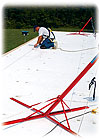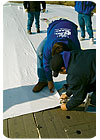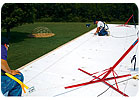Cool Roofing: Beyond Cool and Sustainable
Roughly 10 years after emerging as closely related trends, both cool and sustainable roofing have become increasingly popular mainstream selection criteria as they continue to drive change in commercial roofing market dynamics, roof system design, product innovation, selection priorities, building codes, and legislation.

Roughly 10 years after emerging as closely related trends, both cool and sustainable roofing have become increasingly popular mainstream selection criteria as they continue to drive change in commercial roofing market dynamics, roof system design, product innovation, selection priorities, building codes, and legislation. As industry groups continue to develop universal definitions and objectives for cool and sustainable roofing, government agencies at the federal, state and local level are implementing more standards, regulations, and incentives to encourage, or mandate, the use of energy-efficient and/or sustainable roofing systems.
Today, these trends are creating increased demand for a new class of high-performance roofing (HPR) systems that can satisfy traditional performance criteria - installed cost, performance and longevity - as well as newer criteria - preservation of the environment, energy efficiency and lifecycle costs. In fact, high-performance roofing is part of a larger green building trend toward high-performance buildings, an especially hot topic among environmentally conscientious builders and managers involved with schools and government facilities.

Whole Building Design
The Department of Energy's High-Performance Building initiative defines the objectives of high-performance buildings and "whole-building design" as:
- Energy consumption reductions of 50 percent or more.
- Reduced maintenance and capital costs.
- Reduced environmental impact.
- Increased occupant comfort and health.
- Increased employee productivity.
Contributing significantly toward all of these objectives, an HPR system is a vital, performance-enhancing umbrella that protects buildings from the weather, enhances the performance of other building components, enables uninterrupted operations, and contributes to the health and performance of occupants. Contrary to popular myth, HPR systems that are cool and sustainable do not necessarily involve additional costs. In fact, one essential definition of an HPR system is that it reduces lifecycle costs (LCC) significantly without substantial tradeoffs in performance or longevity.

Checklist for HPR
How can building owners identify a high-performance roof? HPR systems have five important, closely related attributes that make them environmentally friendly, energy efficient, cost-effective, leak-proof, reliable and long-lasting. Think of them as the "Five E's" for making informed, cost-effective roofing choices: energy, environment, endurance, economics and engineering. What follows is a brief discussion of some of the more important checklist items for each to help determine if a roofing system qualifies as "high-performance." (For a comprehensive HPR checklist, visit www.duro-last.com/coolzone).
Energy: Roofing can enhance energy efficiency and overall sustainability performance through insulation and reflective (cool) surfaces. The recent popularity of cool roofing systems stems from the enormous energy savings they are providing to building owners nationwide. Three simple questions can help determine if a roofing system is energy efficient:
- Does the roof meet criteria set by the Environmental Protection Agency's ENERGY STAR Roofing Products Program? Visit www.energystar.com to see if the roofing system is listed. Then, use their online calculator to determine potential energy savings for your building. Energy efficiency also reduces pollution by mitigating the urban heat island effect.
- Does the roof meet ASHRAE Standard 90.1? The American Society of Heating, Refrigeration and Air-Conditioning Engineers (ASHRAE) established Standard 90.1 as a minimum requirement for energy-efficient building design. In 2005, President Bush signed legislation offering tax deductions to buildings that exceed the 90.1 Standard.
- Does the roofing system exceed local building codes for minimum thermal resistance (R-values)? Lawrence Berkeley National Laboratory recently determined that increasing the R-value of a roofing system in Los Angeles from R-9 to R-15 would reduce annual energy costs by $2,500, and lower carbon dioxide emissions by thousands of pounds.
Environment: A popular definition for sustainable roofing was developed during a workshop held at the Oak Ridge National Laboratory (ORNL) in 1996: A roof system that is designed, constructed, maintained, rehabilitated and demolished with an emphasis throughout its life cycle on using natural resources efficiently and preserving the global environment. Three questions to ask about HPR sustainability:
- Is a roof tear-off required? Certain lightweight HPR systems can be installed, fully warranted, directly over the existing roof to reduce disposal costs and landfill buildup.
- Does the roof earn points toward LEED credits?
- Is the roofing material recyclable? ORNL recently estimated that 9 million to 10 million tons of non-recyclable roofing waste is sent to U.S. landfills every year.
Endurance: Endurance is the ultimate reflection of roofing performance in terms of reliability, water absorption, wind and fire resistance, maintenance and repair. Most green building experts agree that longevity is among the most important factors contributing to the sustainability of any building product, including roofing systems. Some basic questions to ask:
- What is the range of service longevity for this type of roofing system with this manufacturer in this area? Other areas?
- In terms of maintenance and repair: How often? How much? How easy? Local references?
- How long, and how good, is the warranty? Warranties reveal many strengths and weaknesses. Small print and exclusions in the warranty can highlight potential problem areas, such as ponding water, consequential damages and repair/replacement procedures in case of failure.

Economics: No matter how "cool" or "sustainable" a roof system is, it won't gain wide acceptance if it does not make economic sense to building owners. The most important question to ask is if a lifecycle cost (LCC) analysis is available that includes all installation costs, estimated maintenance/repair costs and potential energy savings over the life of the roof.
In 2004, a 20-year LCC comparison was prepared with the help of independent Midwest roofing contractors. This LCC compares the lifecycle costs of a reflective PVC single-ply with black EPDM and BUR systems for a fully-warranted, 50,000 square-foot reroof in the Midwest. While actual costs will vary depending on each situation, note the differences between installed costs and lifecycle costs. (See Table 1.)
Engineering: Smart, coordinated engineering and design not only enables every other aspect of HPR, they are essential to "whole-building design," which integrates all components of a high-performance building to work in tandem from "cradle to cradle." Among the more important HPR engineering questions:
- Is this a fully integrated roofing system that provides watertight performance while enhancing the performance of other building components? Check the warranty!
- Does the manufacturer use premium components and state-of-the-art manufacturing processes to enhance performance characteristics such as reflectance, water resistance, ultraviolet and flame resistance?
- Is custom prefabrication an option? Prefabricated roofing systems designed to fit each roof reduce installation time and costs, and minimize errors by producing seams and other critical components under quality-controlled conditions in the factory.

Toward a High-Performance Future
As demand for energy-efficient, environmentally friendly, high-performance buildings grows, so does demand for HPR systems that provide optimal value regarding energy, environment, endurance and economics through intelligent design and engineering. HPR is a protective, performance-enhancing umbrella that protects High-Performance Buildings from the elements, enables uninterrupted facility operations, and contributes to the health and productivity of the building occupants. HPR does not require a tradeoff between "green" and performance or cost. The best HPR systems cost less over time because they reduce energy consumption, minimize environmental impact, require less maintenance and keep the weather outside, where it belongs.
Links
Looking for a reprint of this article?
From high-res PDFs to custom plaques, order your copy today!





